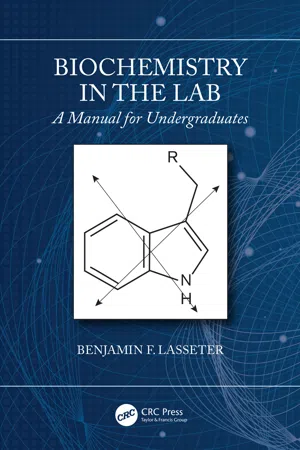
- 168 pages
- English
- ePUB (mobile friendly)
- Available on iOS & Android
About this book
Most lab manuals assume a high level of knowledge among biochemistry students, as well as a large amount of experience combining knowledge from separate scientific disciplines. Biochemistry in the Lab: A Manual for Undergraduates expects little more than basic chemistry. It explains procedures clearly, as well as giving a clear explanation of the theoretical reason for those steps.
Key Features:
- Presents a comprehensive approach to modern biochemistry laboratory teaching, together with a complete experimental experience
- Includes chemical biology as its foundation, teaching readers experimental methods specific to the field
- Provides instructor experiments that are easy to prepare and execute, at comparatively low cost
- Supersedes existing, older texts with information that is adjusted to modern experimental biochemistry
- Is written by an expert in the field
This textbook presents a foundational approach to modern biochemistry laboratory teaching together with a complete experimental experience, from protein purification and characterization to advanced analytical techniques. It has modules to help instructors present the techniques used in a time critical manner, as well as several modules to study protein chemistry, including gel techniques, enzymology, crystal growth, unfolding studies, and fluorescence. It proceeds from the simplest and most important techniques to the most difficult and specialized ones. It offers instructors experiments that are easy to prepare and execute, at comparatively low cost.
Frequently asked questions
- Essential is ideal for learners and professionals who enjoy exploring a wide range of subjects. Access the Essential Library with 800,000+ trusted titles and best-sellers across business, personal growth, and the humanities. Includes unlimited reading time and Standard Read Aloud voice.
- Complete: Perfect for advanced learners and researchers needing full, unrestricted access. Unlock 1.4M+ books across hundreds of subjects, including academic and specialized titles. The Complete Plan also includes advanced features like Premium Read Aloud and Research Assistant.
Please note we cannot support devices running on iOS 13 and Android 7 or earlier. Learn more about using the app.
Information
1 Buffers
| (1.1) |
| (1.2) |
Table of contents
- Cover
- Half-Title
- Title
- Copyright
- Dedication
- Contents
- Author Bio
- Chapter 1 Buffers
- Chapter 2 Assays
- Chapter 3 Protein Concentration
- Chapter 4 ELISA
- Chapter 5 Salting Out Proteins and Other Biomolecules
- Chapter 6 A Discussion of Isoelectric Point and Effective Charge
- Chapter 7 Column Chromatography
- Chapter 8 Michaelis–Menten Kinetics
- Chapter 9 Protein Purification
- Chapter 10 Polyacrylamide Gels
- Chapter 11 In Silico Biochemistry: The Evolution of Globins
- Chapter 12 Growing Crystals of Hemoglobin
- Chapter 13 Enzyme Inhibition
- Chapter 14 Multisubstrate Kinetics
- Chapter 15 Fluorescence and Denaturation
- Chapter 16 Fluorescence Studies of Ligand Binding
- Chapter 17 DNA Restriction Digests
- Chapter 18 Western Blotting
- Index